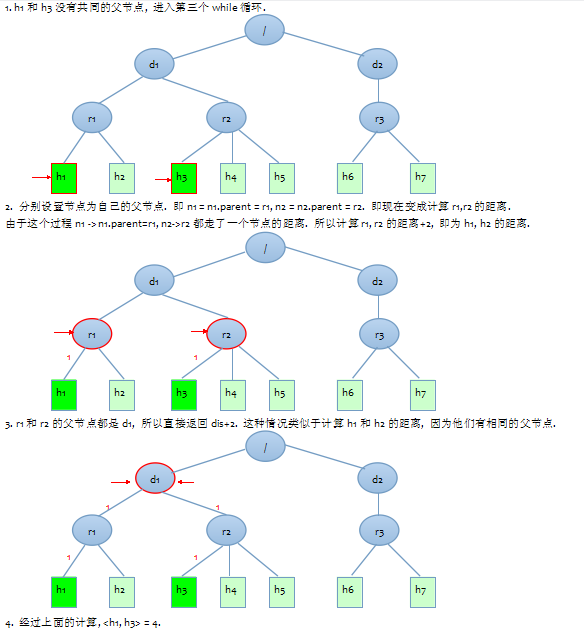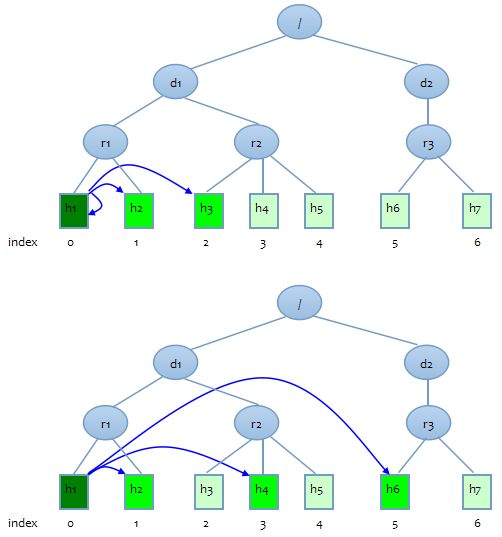图说Hadoop源码-NetworkTopology
NetworkTopology定义了InnerNode为根节点的成员变量clusterMap, 其中的方法都是通过clusterMap调用InnerNode中的相应方法并更新一些其他变量.
比如NetworkTopology.add(Node)会通过clusterMap.add(node)来完成, 并更新NetworkTopology的变量numOfRacks和depthOfAllLeaves.
下面的方法都会在try和finally中, 通过锁netLock执行. 为了篇幅, 下面的方法都省略了try和finally语句.
/** Check if the tree contains Node node*/
public boolean contains(Node node) {
Node parent = node.getParent();
for(int level=node.getLevel(); parent!=null&&level>0; parent=parent.getParent(), level--) {
if (parent == clusterMap)
return true;
}
return false;
}
/** Check if two nodes are on the same rack */
public boolean isOnSameRack( Node node1, Node node2) {
return node1.getParent()==node2.getParent();
}contains: 从叶子节点开始, 一层一层往上寻找父节点. 最终的父节点如果是根节点即clusterMap. 那么节点就在拓扑图中.
isOnSameRack: (叶子/DN)节点的父节点如果相同, 那么他们就是在同一个机架上.
getDistance
/** Return the distance between two nodes. It is assumed that the distance from one node to its parent is 1 节点到父节点的举例为1
* The distance between two nodes is calculated by summing up their distances to their closest common ancestor. 寻找最近的共同祖先. */
public int getDistance(Node node1, Node node2) {
if (node1 == node2) return 0;
Node n1=node1, n2=node2;
int dis = 0;
int level1=node1.getLevel(), level2=node2.getLevel();
while(n1!=null && level1>level2) {
n1 = n1.getParent();
level1--;
dis++;
}
while(n2!=null && level2>level1) {
n2 = n2.getParent();
level2--;
dis++;
}
while(n1!=null && n2!=null && n1.getParent()!=n2.getParent()) {
n1=n1.getParent();
n2=n2.getParent();
dis+=2;
}
return dis+2;
} 计算节点间的距离: 从一个节点到另一个节点在网络拓扑图中经过的边的数量.
下面的网络拓扑图中每个叶子节点的level都为3. 所以代码主要集中在第三个while循环的处理. 以

pseudoSortByDistance
/* swap two array items */
static private void swap(Node[] nodes, int i, int j) {
Node tempNode;
tempNode = nodes[j];
nodes[j] = nodes[i];
nodes[i] = tempNode;
}
/** Sort nodes array by their distances to reader
* It linearly scans the array, if a local node is found, swap it with the first element of the array.
* If a local rack node is found, swap it with the first element following the local node.
* If neither local node or local rack node is found, put a random replica location at postion 0. It leaves the rest nodes untouched. */
public void pseudoSortByDistance( Node reader, Node[] nodes ) {
int tempIndex = 0; // 是否有本地节点的标记位. 如果有设置为1
if (reader != null ) {
int localRackNode = -1; // nodes中和reader同一机架的节点的索引. -1为没有节点和reader同机架, 标志位
for(int i=0; i假设reader=h0(为了和索引从0开始相对应, 记第一个DN为h0), 待排序的DN数组有h0, h1, h2. 其中数组的h0称作local node.
数组的排序有6(3!=3*2*1=6)种方式: [h0, h1, h2] [h0, h2, h1] [h1, h0, h2] [h1, h2, h0] [h2, h0, h1] [h2, h1, h0]
+++++++++++++++++++++++++++++++++++++++++++++++++++++++++++++++++++++++++++++++++
A. [h0, h1, h2]
[01] nodes[0]=h0=reader 数组中存在本地节点
[02] .. i=0, 本地节点不需要交换到数组前面, 因为已经在最前面了
[03] tempIndex=1
[04] localRackNode=-1 ... 继续处理数组的下一个节点h1
[08] h1和reader在同一个机架上.
[09] localRackNode=1, 表示和reader同一机架的节点的索引为1, 即nodes[1]和reader同机架.
[10] tempIndex=1, break
------------------------------------------------------------------------------------------------------------------------------------------------------------------
nodes: [h0, h1, h2]
localRackNode = 1: 本机架节点nodes[1]=h1
tempIndex = 1: 存在本地节点
[..] 因为localRackNode = tempIndex = 1. 所以后面都不执行了 【h0, h1, h2】
+++++++++++++++++++++++++++++++++++++++++++++++++++++++++++++++++++++++++++++++++
B. [h0, h2, h1]
[01] nodes[0]=h0=reader 数组中存在本地节点
[02] .. i=0, 本地节点不需要交换到数组前面, 因为已经在最前面了
[03] tempIndex=1
[04] localRackNode=-1 ... 继续处理数组的下一个节点h1
[..] h2都不满足本地节点和本地机架. 继续处理数组的下一个节点h1
[08] h1和reader在同一个机架上.
[09] localRackNode=2, 表示和reader同一机架的节点的索引为2, 即nodes[2]和reader同机架.
[10] tempIndex=1, break
------------------------------------------------------------------------------------------------------------------------------------------------------------------
nodes: [h0, h2, h1]
localRackNode = 2: 本机架节点nodes[2]=h1
tempIndex = 1: 存在本地节点
[11] localRackNode != tempIndex
[12] 交换localRackNode和tempIndex. 即交换数组中2(localRackNode的值)和1(tempIndex的值)的节点. 即h2和h1交换: [h0, h1, h2]
PS: 交换节点时, localRackNode和tempIndex的值会不会互换? 不会互换, 这两个方法内的变量只起到标志位的作用, 我们的目的是排序数组.
[..] tempIndex++, [13]就不会执行了 【h0, h1, h2】
+++++++++++++++++++++++++++++++++++++++++++++++++++++++++++++++++++++++++++++++++
C. [h1, h0, h2]
[08] h1和reader在同一个机架上.
[09] localRackNode=0, 表示和reader同一机架的节点的索引为0, 即nodes[0]和reader同机架.
[10] tempIndex=0
[01] nodes[1]=h0=reader 数组中存在本地节点
[02] .. i=1, 交换第一个节点(h1)和本地节点(h0)的位置 [h0, h1, h2]
[03] tempIndex=1
[04][05] localRackNode=0, 即数组第一个节点和reader同机架(本地节点不在数组第一个).
[06] 设置localRackNode=i=1. 因为本机架节点(第一个)和本地节点交换. 交换后本机架节点的索引就是交换前的本地节点的位置
[07] break 只要本地节点前有和reader同机架的, 不管是不是数组的第一项. 都会跳出循环
------------------------------------------------------------------------------------------------------------------------------------------------------------------
nodes: [h1, h0, h2] -> [h0, h1, h2]
localRackNode = 1: 本机架节点nodes[1]=h1
tempIndex = 1: 存在本地节点
localRackNode = tempIndex. 同A. [h0, h1, h2] 【h0, h1, h2】
+++++++++++++++++++++++++++++++++++++++++++++++++++++++++++++++++++++++++++++++++
D. [h1, h2, h0]
[08] h1和reader在同一个机架上.
[09] localRackNode=0, 表示和reader同一机架的节点的索引为0, 即nodes[0]和reader同机架.
[10] tempIndex=0
[..] h2都不满足本地节点和本地机架. 继续处理数组的下一个节点h1
[01] nodes[2]=h0=reader 数组中存在本地节点
[02] .. i=2, 交换第一个节点(h1)和本地节点(h0)的位置 [h0, h2, h1]
[03] tempIndex=1
[04][05] localRackNode=0, 即数组第一个节点和reader同机架(本地节点不在数组第一个).
[06] 设置localRackNode=i=2. 因为本机架节点(第一个)和本地节点交换. 交换后本机架节点的索引就是交换前的本地节点的位置
------------------------------------------------------------------------------------------------------------------------------------------------------------------
nodes: [h1, h2, h0] -> [h0, h2, h1]
localRackNode = 2: 本机架节点nodes[2]=h1
tempIndex = 1: 存在本地节点
localRackNode != tempIndex, 同B. [h0, h2, h1] -> [h0, h1 , h2] 【h0, h1, h2】
+++++++++++++++++++++++++++++++++++++++++++++++++++++++++++++++++++++++++++++++++
E. [h2, h0, h1]
[..] h2都不满足本地节点和本地机架. 继续处理数组的下一个节点h1
[01] nodes[1]=h0=reader 数组中存在本地节点
[02] .. i=1!=0, 交换第一个节点(h2)和本地节点(h0)的位置 [h0, h2, h1]
[03] tempIndex=1
[04] localRackNode=-1 ... 继续处理数组的下一个节点h1
[08] h1和reader在同一个机架上.
[09] localRackNode=2, 表示和reader同一机架的节点的索引为2, 即nodes[2]和reader同机架.
[10] tempIndex=1, break
------------------------------------------------------------------------------------------------------------------------------------------------------------------
nodes: [h2, h0, h1] -> [h0, h2, h1]
localRackNode = 2: 本机架节点nodes[2]=h1
tempIndex = 1: 存在本地节点
localRackNode != tempIndex, 同B. [h0, h2, h1] -> [h0, h1, h2] 【h0, h1, h2】
+++++++++++++++++++++++++++++++++++++++++++++++++++++++++++++++++++++++++++++++++
F. [h2, h1, h0]
[..] h2都不满足本地节点和本地机架. 继续处理数组的下一个节点h1
[08] h1和reader在同一个机架上.
[09] localRackNode=1, 表示和reader同一机架的节点的索引为1, 即nodes[1]和reader同机架.
[10] tempIndex=0
[01] nodes[2]=h0=reader 数组中存在本地节点
[02] .. i=2!=0, 交换第一个节点(h2)和本地节点(h0)的位置 [h0, h1, h2]
[03] tempIndex=1
[04] localRackNode=1
[07] break
------------------------------------------------------------------------------------------------------------------------------------------------------------------
nodes: [h2, h1, h0] -> [h0, h1, h2]
localRackNode = 1: 本机架节点nodes[1]=h1
tempIndex = 1: 存在本地节点
localRackNode = tempIndex. 同A. [h0, h1, h2] 【h0, h1, h2】
+++++++++++++++++++++++++++++++++++++++++++++++++++++++++++++++++++++++++++++++++
**[*, *, *] -> [h0, h1, h2]**
存在本地节点和本机架节点的情况下, 最后数组都会排列成[h0, h1, h2]
**循环次数:**
A. [h0, h1, h2]
C. [h1, h0, h2] -> [h0, h1, h2]
如果数组的前两个节点分别是本地节点和本机架节点, 则后面的节点不会再执行了. 说明只排序了两次, 所以也叫做伪排序.
**tempIndex == localRackNode**
tempIndex取值要么为0表示不存在本地节点, 要么为1表示存在本地节点.
localRackNode表示数组中和reader同一机架的节点的位置. 取值可以为数组的任意一项.
localRackNode如果等于tempIndex=0/1. 即本机架节点在数组的第一项nodes[0]或者第二项nodes[1].
localRackNode = tempIndex = 0时表示, 不存在本地节点, 本机架节点为nodes[0].
不存在本地节点, 但存在本机架节点. 那么本机架节点应该排列在数组的第一个位置.
localRackNode = tempIndex = 1时表示, 本机架节点为nodes[1], 本地节点为nodes[0]
存在本地节点, 本地节点优于本机架节点. 所以本地节点应该排在数组的第一个位置.
**localRackNode !=-1, tempIndex != localRackNode**
tempIndex=0, localRackNode=1,2.... 不存在本地节点, 本机架节点应该在数组的第一项, 进行交换操作, 交换本地节点到nodes[0]
tempIndex=1, localRackNode=2,... 存在本地节点, 因为本地节点优于本机架节点. 所以本地节点已经在第一项了.
localRackNode应该从数组第三项即nodes[2]开始(不能为0, 因为已经被本地节点占了, 不能为1, 因为!=的约束).
那么本机架节点要交换到数组的第二项, 即nodes[1]处. 紧跟着本地节点后面.
也就是说如果本地节点和本机架几点都存在的情况下, 排列顺序依次是本地节点, 本机架节点...
测试用例3 - pseudoSort
public void printLocalNodeAndLocalRack(DatanodeDescriptor[] testNodes){
cluster.pseudoSortByDistance(dataNodes[0], testNodes );
assertTrue(testNodes[0] == dataNodes[0]);
assertTrue(testNodes[1] == dataNodes[1]);
assertTrue(testNodes[2] == dataNodes[2]);
}
public void nodeIndex(DatanodeDescriptor[] testNodes, int[] nodeIndex){
for(int i=0;i<3;i++){
testNodes[i] = dataNodes[nodeIndex[i]];
}
}
public void testPseudoSortByDistance() throws Exception {
DatanodeDescriptor[] testNodes = new DatanodeDescriptor[3];
int[][] index = new int[][]{
{0,1,2}, {0,2,1}, {1,0,2}, {1,2,0}, {2,0,1}, {2,1,0},
};
for(int i=0; i public void testPseudoSortByDistance() throws Exception {
DatanodeDescriptor[] testNodes = new DatanodeDescriptor[3];
// array contains both local node & local rack node
testNodes[0] = dataNodes[1];
testNodes[1] = dataNodes[2];
testNodes[2] = dataNodes[0];
cluster.pseudoSortByDistance(dataNodes[0], testNodes );
assertTrue(testNodes[0] == dataNodes[0]);
assertTrue(testNodes[1] == dataNodes[1]);
assertTrue(testNodes[2] == dataNodes[2]);
// array contains local node
testNodes[0] = dataNodes[1];
testNodes[1] = dataNodes[3];
testNodes[2] = dataNodes[0];
cluster.pseudoSortByDistance(dataNodes[0], testNodes );
assertTrue(testNodes[0] == dataNodes[0]);
assertTrue(testNodes[1] == dataNodes[1]);
assertTrue(testNodes[2] == dataNodes[3]);
// array contains local rack node
testNodes[0] = dataNodes[5];
testNodes[1] = dataNodes[3];
testNodes[2] = dataNodes[1];
cluster.pseudoSortByDistance(dataNodes[0], testNodes );
assertTrue(testNodes[0] == dataNodes[1]);
assertTrue(testNodes[1] == dataNodes[3]);
assertTrue(testNodes[2] == dataNodes[5]);
}

